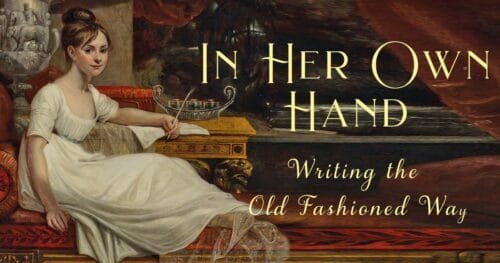The Regency Laptop

In 1844, Thomas Griffiths wrote “EXPERIMENTAL science may be pursued to a considerable extent, without the aid of costly and complicated apparatus; indeed many of its important truths have been discovered, and may be illustrated, by ” the employment of things familiar … The following pages will explain my plan, and may possibly be taken as a text-book by those whose duty it is to teach the rudiments of science … and I shall reflect with pleasure upon this attempt to condense the science of THE LECTURE-TABLE into the contents of THE WRITING-DESK .”
But what was the writing desk of which he spoke, and why did it make such an ideal place to begin his science lessons? Possibly because it was a highly relatable item, filled with a huge variety of items from which to begin his science lessons on.
The Writing Desk

For centuries, throughout the world, writing materials have been stored in portable boxes. It was only at the end of the 18th century that the need for a portable writing surface became widespread enough for the development of the portable writing desk. During the Georgian, Regency, and Victorian Eras, homes lacked efficient heating and electric lighting, making it sensible for individuals to write in the warmest, brightest space available, which might or might not have the correct furniture for writing. Moreover, visits to family and friends might last weeks or months, during which time letter writing would be essential. Thus, a convenient, portable writing surface simply made sense. Like the tea caddy, and sewing box, the writing desk was a personal item that served both practical and decorative functions.
Early Writing Desks
Prior to 1780, before their popularity surged, writing boxes were largely rectangular with shallower sloping tops than the earlier bible boxes that predated them. These boxes had side drawers for paper and compartments for ink and sand as well.

This box could store accessories for both writing and dressing.
The onset of the Napoleonic wars and the subsequent increase in the popularity of travel, writing boxes took on a flatter shape which made them easier to transport. The most popular style between 1780 and 1800 resembled a military chest.
Made of mahogany, these rectangular boxes ranged from eight to twenty inches long, ten inches deep and seven inches tall. When opened, they formed a sloped writing surface with space at the top for writing tools like inkwells, sand shakers, pen holders and the like. In the example here, a bottom drawer pulled out to support the lower side of the writing slope. Side drawers stored these materials when they were not in use. Brass corners and handles strengthened the boxes and offered decorative appeal.
These boxes could be tailored to special uses as well. Some incorporated compartments for personal grooming items. Others incorporated a small printing machine, reminiscent of a mimeograph machine, for making copies of maps, dispatches and the like. Boxes destined for use at sea might include secret compartments, space to hold candlesticks securely, and a mechanism allowing them to be screwed down to a table for stability.
Writing desks of the Regency Era

During the Regency Era, writing boxes became more decorative. More brass decorations were used, as well as attractive veneers and polishes. Military features diminished and gave way to more ambitious ornamentation including floral designs, marquetry and mother of pearl inlays. From a practical standpoint, the writing surfaces became a bit larger, and secret drawers gained popularity over ordinary side drawers.
Victorian Writing Desks

The inventions of the steel pen nib in 1830 and the adoption of the Penny post in 1840, which meant senders rather than recipients could pay for the post, increased letter traffic tenfold over the next decade. A showcase of writing desks at the Great Exhibition of 1851 further increased demand. Demand and industrialization meant that writing desks became more available and more affordable to the Victorian middle class.
Ubiquitous as the laptop computer is today, the writing desk or writing slope, played major role in the creation of novels by Jane Austen, the Brontës, and others, that still enjoy wide readership today.
A Gallery of Writing Desks






References
Clark, Antigone. Antique Boxes in English Society 1760-1900: Writing Boxes. The Sign of the Hygra. Accessed February 1, 2024 https://www.hygra.com/writing.html.a
Golden, Catherine J. Posting It: The Victorian Revolution in Letter Writing. Gainesville: University Press of Florida, 2009.
Golden, Catherine. The Portable Writing Desk—the Victorian Laptop. The Victorian Web. June 7, 2010Accessed February 1, 2024 https://victorianweb.org/art/design/furniture/golden1.html
Great Exhibition of the Works of Industry of all Nations, 1851. Official Descriptive and Illustrated Catalogue. By Authority of the Royal Commission. In Three Volumes. London: Spicer Brothers, 1851.
Griffiths, Thomas. The Writing-Desk and its Contents. John W. Parker: London. 1844
Harris, David. Portable Writing Desks. Buckinghamshire, UK: Shire Publications Ltd., 2001.
Sanford, Vic. Jane Austen’s Writing (Sloping) Desk. Jane Austen’s World. April 9. 2009. Accessed February 1, 2024. https://janeaustensworld.com/2009/04/09/jane-austens-writing-or-sloping-desk/


A very interesting post! Turns out I didn’t know all that much about writing desks and I’ve never even heard of mimeograph machines! Now I feel I need to use one in a book 🙂
What did they use the *sand* for? That bit I’ve never understood (nor, to be frank, taken the time to investigate).
I think it was used to soak up extra ink the quill may have left on the paper.
I’ve always wanted one of those. My cousin enjoys woodworking as a hobby. I’ve been trying to get him to make me something like this and a box for my ashes when I pass on. He was highly offended and refused. What? I didn’t get it. Good Grief! You would have thought I asked for his firstborn. Heavens. Anyway, I’ve always loved looking at the different styles of slopes or writing desks in movies and online. Blessings.